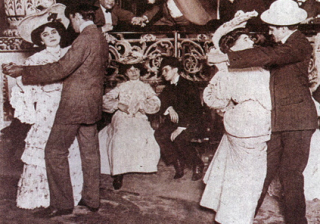 En lo de Laura (At Laura's Place)
En lo de Laura (At Laura's Place)
Milonga
Music: Antonio Polito
Lyrics: Enrique Cadícamo
"The tango is the simplest thing, it's pulse, it's strength, it's an inner emotion that you throw on the keys and bring out an effect. It is not boasting, that is another thing."—Enrique Cadícamo
Poet, novelist, and composer Enrique Cadícamo (July 15, 1900-December 3, 1999) was was one of tango's greatest and most prolific lyricists. In addition to his own compositions (see below for a list of Tango Decoder version of Cadícamo's lyrics) he wrote lyrics for many of the genre's finest songwriters including Augustín Bardi, Augustín Magaldi, Juan Carlos Cobian, Julio De Caro, Osvaldo Pugliese, Aníbal Troilo, Angel D'Agostino, Luis Visca, Charlo, and many others. Twenty-three of his songs were recorded by Carlos Gardel, beginning with Pompas de jabón in 1925 and ending with Gardel's final recording in Argentina, Madame Ivonne, in 1933. His works were recorded by the típicas of Di Sarli, D'Arienzo, Troilo, D'Agostino, Pugliese, and many more.
Cadícamo's lyric for En lo de Laura ("At Laura's place") is a poetic evocation of an early tango dance hall hosted by "la Morocha" Laura Montserrat in the last years of the nineteenth century and the first years of the twentieth at Paraguay 2512. (It was still open in 1915; no one is quite sure when it finally closed its doors.) Laura's was luxurious, had a wealthy clientele—which included many jockeys and other figures of the horse-racing community—and often featured the legendary pianist "El Negro" Rosendo Medizábal (1868-1913), composer of El entrerriano, believed to be the oldest tango in the modern repertoire.
MORE ENRIQUE CADÍCAMO SONGS ON TANGO DECODER:
A quién le puede importar • Argañaraz • Ave de paso • Compadrón • El cuarteador • Muñeca brava • Naipe • No vendrá • Pa' mi es igual • Si la llegaran a ver • Son cosas del bandoneón • Tres amigos • Tres esquinas • Tu llamado • Un dilema
MORE MILONGA LYRICS ON TANGO DECODER:
Sacale Punta (Donato/Lagos 1938)
Milonga Criolla (Canaro/Maida 1936)
Ella Es Así (Donato/Lagos 1938)
Larga Las Penas (Canro/Maida 1935)
Milongón (Lomuto/Omar 1939)
Negra Maria (Demare/Miranda 1941)
TANGO DECODER SONG INDEX
|
Milonga de aquel entonces
[Milonga de mil recuerdos
Amigos de antes, cuando chiquilín,
|
Milonga from way back when [Milonga of a thousand memories, Old friends, when just a tot, |
* Troublemaker milonga…reputation for bravery: Legend has it that fights were not uncommon at Lo de Laura, and they could involve women as well as men. The tango Tiempos Viejos includes the following lines:
Where are the real women,
faithful girls, all heart,
who used to mix it up at Laura’s dances,
each one defending her man?
* track of life…rounding the final turn: doblando el codo. Literally, bending the elbow. The expression is used in horse racing when a horse rounds the final turn and heads for the finish. It also means, "to grow old," especially when one's age is greater than the number of years left in life. The word pista has a double meaning. It is a race track, but it may also be a dance floor.
* compadrito dancer: Bailarín compadrito. The compadrito was "an early-20th-century imitation of the historically prior guapo…. distinguished by gratuitous provocation, false pride, and the claim to great deeds which were not his own." (Blas Raúl Gallo, cited in El Tango by Horacio Salas, Editorial Planeta Argentina, 1986) The use of the term here is not derogatory, however. Despite his socially undesirable qualities, the compadrito maintained a unique style of gesture, physical movement, and dress, and is believed to have made a signal contribution to the development of tango dance. The bailarín compadrito was memorialized in an eponymous song bearing the same name by Manuel Bucino, composed in 1929 and recorded by Gardel in the same year, and later recorded by Troilo, D'Arienzo, D'Agostino, and De Angelis.
* black jacket…checkered pants: The passage describes elements of the typical costume of the compadrito.
* Pepita Avellaneda: Psuedonym of Josefa Carlattio (Montevideo?, 1874 – Buenos Aires, 21 de julio de 1951), singer and dancer whose career developed mostly in Argentina. She was one of the very first women to sing tangos and the first woman singer to adopt the style of dressing in men's clothes later favored by Azucena Maizani and others. Her artistic apogee ended in 1910, and she passed her later years as the operator of the ladies coat-check at the Chanteceler cabaret.
